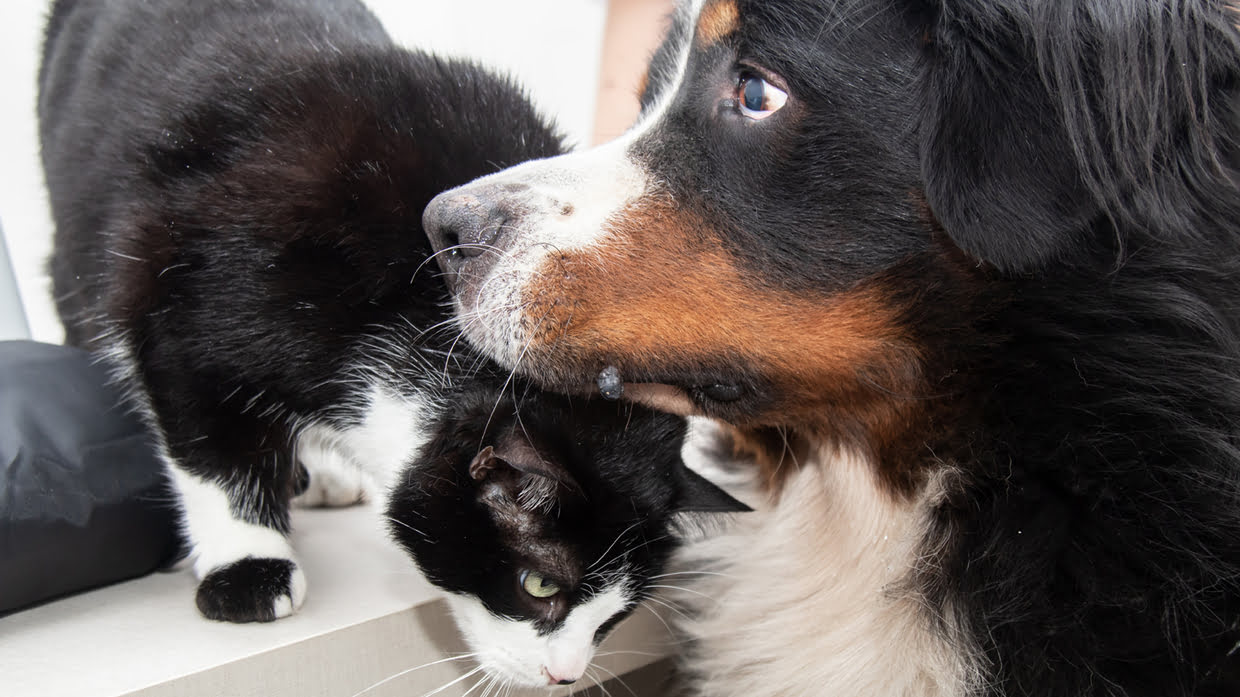Home>Health & Wellness>Common Health Issues>Why Are There More Cat Allergies Than Dog Allergies


Common Health Issues
Why Are There More Cat Allergies Than Dog Allergies
Modified: February 20, 2024
Learn about the reasons behind the prevalence of cat allergies compared to dog allergies and how to manage these common health issues.
(Many of the links in this article redirect to a specific reviewed product. Your purchase of these products through affiliate links helps to generate commission for Pawsomeoldies.com, at no extra cost. Learn more)
Table of Contents
Introduction
Allergies are a common health concern that affects millions of people worldwide. While both cats and dogs are beloved pets, there is a notable discrepancy in the prevalence of allergies associated with each. It's a curious phenomenon that has puzzled many pet owners and allergy sufferers alike. In this article, we will delve into the reasons behind the higher incidence of cat allergies compared to dog allergies. By exploring the differences in allergens, the influence of breeds, environmental factors, and genetic predisposition, we aim to shed light on this intriguing disparity. Understanding the factors contributing to these allergies is crucial for pet owners, allergy sufferers, and healthcare professionals alike. So, let's embark on this enlightening journey to unravel the mystery of cat and dog allergies.
Read more: Why Are Fleas More Attracted To Dogs
The Difference in Cat and Dog Allergens
When it comes to pet allergies, the primary culprits are the proteins found in the saliva, dander, and urine of cats and dogs. These proteins, known as allergens, can trigger allergic reactions in susceptible individuals. The key disparity lies in the specific allergens produced by cats and dogs, which can elicit varying immune responses in humans.
Cat allergens are predominantly produced in the sebaceous glands of the skin and are present in the cat's saliva. When cats groom themselves, these allergens are transferred to their fur and skin. In contrast, dog allergens are primarily found in their dander, which consists of tiny, often-invisible flecks of skin shed by the animal. Additionally, proteins in dog saliva can also contribute to allergic reactions in sensitive individuals.
One of the most significant distinctions between cat and dog allergens is the size of the particles. Cat allergens are smaller and lighter, allowing them to remain airborne for extended periods. This airborne nature of cat allergens makes them more likely to be inhaled, leading to respiratory symptoms such as sneezing, coughing, and wheezing. On the other hand, dog allergens, being larger and heavier, tend to settle more quickly, resulting in a lower likelihood of airborne transmission.
Furthermore, the composition of the allergens differs between cats and dogs. Fel d 1, a protein found in cat saliva, is a potent allergen known to trigger severe allergic reactions in susceptible individuals. In contrast, dog allergens such as Can f 1 and Can f 2 are also found in saliva but may elicit milder allergic responses in some individuals.
Understanding these distinctions in cat and dog allergens is crucial for individuals with pet allergies, as it can guide them in making informed decisions about pet ownership and allergen avoidance strategies. Additionally, healthcare professionals can utilize this knowledge to provide tailored advice and treatment options to patients with pet allergies.
In the subsequent sections, we will delve deeper into the role of cat and dog breeds, environmental factors, and genetic predisposition in influencing the prevalence of cat and dog allergies. This comprehensive exploration will provide valuable insights into the complex interplay of factors contributing to the higher incidence of cat allergies compared to dog allergies.
The Role of Cat and Dog Breeds
When considering the prevalence of cat and dog allergies, the role of specific breeds within each species cannot be overlooked. While all cats produce the allergen Fel d 1 and all dogs produce Can f 1 and Can f 2, the levels of these allergens can vary significantly among different breeds. This variation can have a notable impact on the likelihood of triggering allergic reactions in susceptible individuals.
In the feline world, certain cat breeds are known to produce lower levels of the Fel d 1 allergen, making them potentially more tolerable for individuals with cat allergies. For instance, the Balinese, Russian Blue, and Siberian breeds are often considered hypoallergenic or low-allergen cats. These breeds are reported to produce lower amounts of Fel d 1 protein, thereby reducing the risk of provoking allergic symptoms in sensitive individuals. Additionally, some hairless cat breeds, such as the Sphynx, are perceived as hypoallergenic due to their minimal shedding and reduced dander production.
On the canine front, the concept of hypoallergenic dog breeds has garnered significant attention. While no dog breed is entirely hypoallergenic, certain breeds are recognized for producing lower levels of allergens, thus potentially posing less risk to individuals with dog allergies. Breeds such as the Poodle, Bichon Frise, and Portuguese Water Dog are often touted as hypoallergenic due to their minimal shedding and production of less dander. These breeds are sought after by individuals with dog allergies in the hope of minimizing allergic reactions.
It is important to note that individual variations in allergen sensitivity can influence the perceived hypoallergenic nature of specific cat and dog breeds. While certain breeds may be associated with lower allergen production on average, allergic reactions can still occur in some individuals when exposed to these breeds. Factors such as the frequency of grooming, the pet's living environment, and the individual's immune response all play a role in determining the extent of allergic reactions.
The role of cat and dog breeds in influencing pet allergies underscores the complexity of this issue. While hypoallergenic breeds may offer hope to individuals with pet allergies, it is essential to approach the selection of a pet with caution and realistic expectations. Understanding the interplay between breed-specific allergen levels and individual sensitivity is crucial for making informed decisions regarding pet ownership in the context of allergies.
By acknowledging the influence of cat and dog breeds on allergen production, individuals can navigate the world of pet ownership with greater awareness and consideration for their unique allergy-related needs. This knowledge empowers pet owners and allergy sufferers to make well-informed choices, fostering harmonious and health-conscious relationships between humans and their beloved animal companions.
Environmental Factors
Environmental factors play a pivotal role in shaping the prevalence and impact of cat and dog allergies. The living environment of pets, including the cleanliness of the home, the presence of other allergens, and the level of pet exposure, can significantly influence the manifestation and severity of allergic reactions in susceptible individuals.
One of the key environmental factors contributing to pet allergies is the presence of airborne allergens in the indoor environment. Cat and dog allergens, being lightweight and easily dispersed, can accumulate in household dust and persist in the air for prolonged periods. This is particularly relevant for individuals with pet allergies, as continuous exposure to airborne allergens can exacerbate their symptoms. Additionally, inadequate ventilation and air filtration in indoor spaces can contribute to higher allergen concentrations, further intensifying allergic reactions.
The cleanliness of the living environment also plays a crucial role in mitigating pet allergen exposure. Regular and thorough cleaning practices, including vacuuming carpets, washing pet bedding, and dusting surfaces, can help reduce the accumulation of pet dander and allergens in the home. Furthermore, the use of high-efficiency particulate air (HEPA) filters in vacuum cleaners and air purifiers can aid in capturing and removing airborne allergens, thereby improving indoor air quality for individuals with pet allergies.
Another environmental consideration is the coexistence of other allergens alongside cat and dog allergens. Common indoor allergens such as dust mites, pollen, and mold can interact with pet allergens, amplifying the overall allergic burden on sensitive individuals. This interplay of multiple allergens underscores the complexity of managing pet allergies within the broader context of indoor environmental quality.
The level of pet exposure in the living environment also influences the development and persistence of pet allergies. Individuals with continuous and close contact with cats or dogs, whether through pet ownership or frequent interaction with animals in their surroundings, are at a higher risk of experiencing allergic symptoms. Conversely, minimizing direct pet contact and creating designated pet-free zones within the home can help reduce allergen exposure and alleviate allergic reactions in susceptible individuals.
Understanding and addressing these environmental factors are essential for effectively managing cat and dog allergies. By implementing proactive measures to minimize allergen exposure, improving indoor air quality, and creating pet-friendly yet allergy-conscious living spaces, individuals can mitigate the impact of pet allergies on their health and well-being.
In the next section, we will explore the role of genetic predisposition in shaping the susceptibility to cat and dog allergies, providing further insights into the multifaceted nature of these prevalent health concerns.
Genetic Predisposition
Genetic predisposition plays a fundamental role in shaping an individual's susceptibility to cat and dog allergies. The interplay of genetic factors contributes to the complex and multifaceted nature of allergic responses, influencing the likelihood of developing pet allergies and the severity of allergic symptoms.
Research has revealed that individuals with a family history of allergies, including asthma, eczema, and allergic rhinitis, are more prone to developing pet allergies. This familial pattern underscores the genetic component of allergic predisposition, highlighting the inheritance of immune system characteristics that can heighten allergic sensitivity to pet allergens.
Furthermore, specific genetic variations related to immune system function and the body's response to allergens have been identified as contributing factors to the development of pet allergies. Variants in genes associated with the production of immunoglobulin E (IgE), a key player in allergic reactions, can influence an individual's susceptibility to pet allergens. Additionally, genetic polymorphisms related to the expression of inflammatory mediators and immune regulatory pathways can impact the severity of allergic responses upon pet allergen exposure.
The intricate interplay of genetic predisposition and environmental factors further shapes the manifestation of pet allergies. While genetic susceptibility lays the foundation for allergic predisposition, environmental triggers such as pet exposure, allergen levels in the living environment, and other coexisting allergies can modulate the expression and progression of pet allergies in genetically predisposed individuals.
Understanding the genetic underpinnings of pet allergies holds significant implications for personalized approaches to allergy management and treatment. By recognizing the genetic predisposition of individuals to pet allergies, healthcare professionals can tailor diagnostic strategies, preventive measures, and therapeutic interventions to address the specific needs of patients with allergic sensitivities to cats and dogs.
Moreover, ongoing research into the genetic determinants of pet allergies offers promising avenues for the development of targeted allergy treatments and novel therapeutic approaches. By unraveling the genetic intricacies of allergic predisposition, researchers aim to pave the way for precision medicine strategies that optimize allergy management and improve the quality of life for individuals affected by pet allergies.
In essence, genetic predisposition stands as a pivotal factor in shaping the landscape of pet allergies, underscoring the intricate interplay of genetic and environmental influences in determining allergic susceptibility and responses. This deeper understanding of genetic predisposition provides valuable insights into the personalized management of pet allergies, fostering advancements in allergy research and clinical practice.
Read more: Who Gets More Fleas: Cats Or Dogs
Conclusion
In conclusion, the higher prevalence of cat allergies compared to dog allergies stems from a multifaceted interplay of factors, encompassing the distinctive nature of cat and dog allergens, the influence of specific breeds, environmental considerations, and genetic predisposition. The differences in allergen composition, particle size, and airborne characteristics between cats and dogs contribute to the varying impact of their allergens on human health. Additionally, the levels of allergens produced by specific cat and dog breeds, coupled with individual variations in allergen sensitivity, underscore the complexity of pet allergy dynamics.
Environmental factors, including indoor allergen exposure, cleanliness of living spaces, and the presence of other allergens, significantly shape the manifestation and severity of cat and dog allergies. The level of pet exposure and the coexistence of multiple allergens further contribute to the intricate landscape of pet allergies, highlighting the importance of proactive measures to minimize allergen exposure and improve indoor air quality.
Moreover, genetic predisposition plays a fundamental role in determining an individual's susceptibility to pet allergies. The inheritance of immune system characteristics and specific genetic variations related to allergic responses underscore the genetic underpinnings of pet allergies. This genetic component, in conjunction with environmental triggers, modulates the expression and progression of pet allergies, emphasizing the personalized nature of allergy management and treatment.
By comprehensively exploring the factors contributing to the higher incidence of cat allergies, we gain valuable insights into the complex nature of pet allergies and the diverse considerations that influence their prevalence and impact. This deeper understanding empowers individuals, healthcare professionals, and researchers to adopt tailored approaches to allergy management, fostering informed decision-making, personalized interventions, and advancements in allergy research.
Ultimately, the elucidation of the disparities between cat and dog allergies serves as a catalyst for promoting awareness, facilitating informed pet ownership decisions, and advancing allergy management strategies. By embracing a holistic understanding of pet allergies, we can strive towards creating harmonious and health-conscious environments that accommodate the needs of both pet owners and individuals with allergic sensitivities, fostering inclusive and well-informed relationships between humans and their beloved animal companions.














